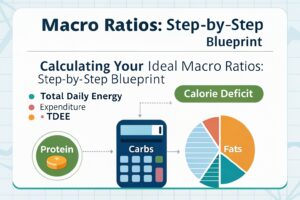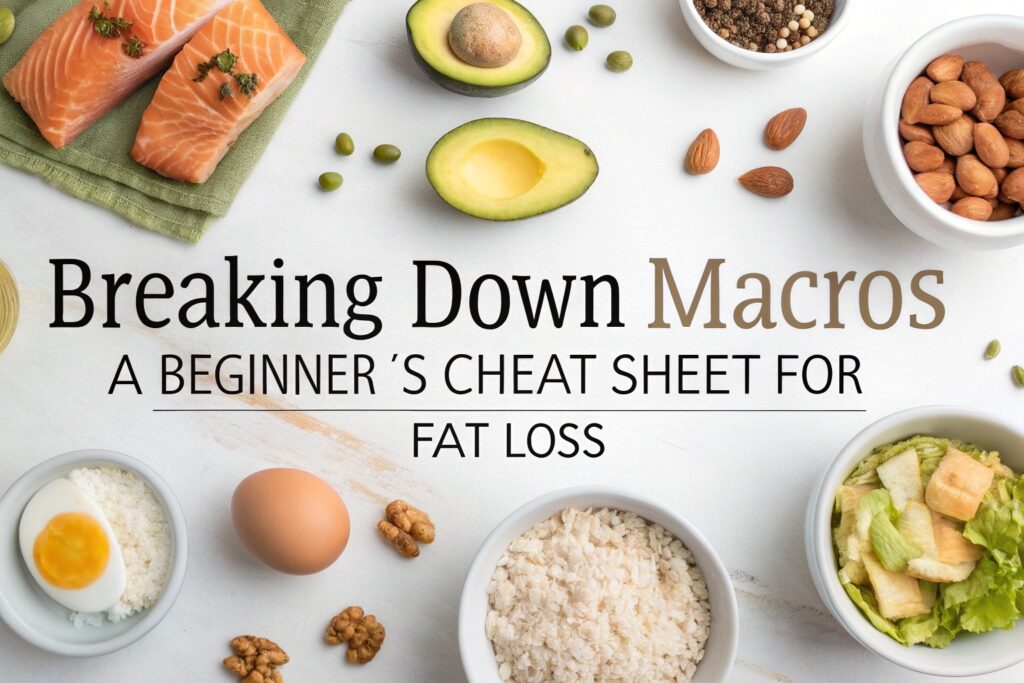Introduction
If you’ve ever felt overwhelmed by the flood of diet advice, you’re not alone. “Breaking Down Macros: A Beginner’s Cheat Sheet for Fat Loss” is designed to cut through the noise and give you a clear, science‑backed roadmap for using macronutrients to shed unwanted pounds while preserving lean muscle. In the next few minutes you’ll learn how to calculate, balance, and fine‑tune your protein, carbohydrate, and fat intake—no PhD in nutrition required.
Understanding macros isn’t just a fad; it’s a proven strategy embraced by athletes, clinicians, and certified nutrition specialists alike. By the end of this post you’ll not only know the numbers that fit your body, but also how to apply them in everyday meals progress confidently, and avoid common pitfalls that sabotage fat‑loss efforts. Let’s dive in and empower your journey with data, expert insight, and actionable steps.
Section 2 – The Fundamentals: What Are Macronutrients and Why Do They Matter?
Defining Protein, Carbs, and Fats
Macronutrients—protein, carbohydrates, and fats—are the three dietary pillars that supply the energy (calories) your body needs to function. Protein delivers amino acids that rebuild muscle fibers, enzymes, and hormones; it also has the highest thermic effect of food (TEF), meaning you burn roughly 20‑30 % of protein calories during digestion (American Journal of Clinical Nutrition, 2015). Carbohydrates are the body’s preferred fuel for high‑intensity effort, stored as glycogen in muscles and the liver; each gram provides 4 kcal. Dietary fats are energy‑dense (9 kcal per gram) and critical for hormone production, cell membrane integrity, and satiety signaling. Understanding the distinct role of each macro allows you to manipulate them strategically for fat loss while maintaining performance and health.
How Macros Influence Body Composition
When you aim to lose weight, the primary driver is a calorie deficit, but how those calories are distributed determines whether you lose primarily fat or also precious lean muscle. Studies consistently show that higher protein intakes (≥ 1.6 g/kg body weight) preserve muscle mass during calorie restriction (Journal of Nutrition, 2018). Conversely, too‑low carbohydrate intake can impair high‑intensity training, while insufficient fat may disrupt hormone balance, especially testosterone and thyroid hormones, leading to a stalled metabolism. By balancing macros—often starting with a protein‑first approach— you create an environment where the body preferentially oxidizes stored fat while sparing muscle, delivering a “lean‑loss” rather than a “weight‑loss” outcome.
Section 3 – Calculating Your Ideal Macro Ratios: A Step‑by‑Step Blueprint

Step 1: Determine Your Maintenance Calories
Begin with a reliable Total Daily Energy Expenditure (TDEE) estimate. The Mifflin‑St Jeor equation, validated across diverse populations, remains the gold standard:
Men: 10 × weight(kg) + 6.25 × height(cm) – 5 × age + 5
Women: 10 × weight(kg) + 6.25 × height(cm) – 5 × age – 161
Multiply the result by an activity factor (1.2 = sedentary, 1.55 = moderately active, 1.9 = very active). For a 30‑year‑old female, 65 kg, 165 cm, moderately active, the calculation yields ~2,200 kcal maintenance. This figure is the foundation for your calorie deficit.
Step 2: Set Your Deficit and Protein Baseline
A safe, sustainable deficit is 15‑20 % of maintenance—roughly 300‑450 kcal for most adults. In the example above, a 20 % deficit yields ~1,760 kcal. Next, allocate protein first: 1.8 g per kilogram of lean body mass (LBM) is a common starting point for fat‑loss athletes. Assuming 20 % body fat, LBM ≈ 52 kg, so protein = 94 g (≈ 376 kcal). This high protein budget ensures satiety, muscle preservation, and a favorable thermic effect.
Step 3: Distribute Carbs and Fats Based on Lifestyle
The remaining calories (1,760 – 376 = 1,384 kcal) can be split between carbs and fats according to personal preference, training intensity, and dietary adherence. A “moderate‑carb” approach might allocate 40 % of the remainder to carbs (≈ 554 kcal ≈ 139 g) and 60 % to fats (≈ 830 kcal ≈ 92 g). For a high‑intensity weight‑lifting schedule, you could flip the ratio (50 % carbs, 50 % fats) to boost glycogen stores. The key is flexibility: track your energy, performance, and hunger cues for 2‑3 weeks, then adjust ratios by 5‑10 % increments until you hit the sweet spot.
Section 4 – Real‑World Applications: Comparing Popular Macro Strategies
Low‑Carb vs. Moderate‑Carb for Fat Loss
Low‑carb protocols (e.g., < 50 g carbs/day) often produce rapid weight loss due to glycogen depletion and water loss, which can be motivating but sometimes misleading. A meta‑analysis of 13 randomized controlled trials (RCTs) found no significant difference in long‑term fat loss between low‑carb and moderate‑carb diets when protein and calorie intake were matched (Nutrients, 2020). However, low‑carb eaters report higher satiety and reduced cravings, potentially improving adherence for those sensitive to sugar spikes. Moderate‑carb plans, on the other hand, better support high‑intensity training and have a lower risk of nutrient deficiencies, making them a balanced choice for most beginners.
Higher‑Fat (Ketogenic) vs. Higher‑Carb (Athlete‑Style) Approaches
A ketogenic diet (≈ 70 % calories from fat) forces the body into ketosis, burning ketone bodies for fuel. While some athletes experience improved endurance, evidence suggests a modest decrease in anaerobic performance (J. Strength Cond. Res., 2019). In contrast, an “athlete‑style” macro split (≈ 55 % carbs, 25 % protein, 20 % fat) fuels both aerobic and anaerobic activities, preserving sprint capacity and VO₂max. For beginners whose primary goal is fat loss rather than competitive sport, the athlete‑style approach offers a more versatile energy system without the restrictive mindset that can trigger binge episodes.
Challenges and How to Overcome Them
Common obstacles include mis‑tracking (under‑estimating portion sizes), “macro fatigue” (getting bored with repetitive meals), and social pressure at events. Solutions: use a reliable app (MyFitnessPal, Cronometer) with barcode scanning; rotate macro‑friendly recipes weekly to maintain variety; and practice “macro‑flex” tactics—allow a 10‑15 % buffer for unplanned meals, then recalibrate the next day. Additionally, lean on evidence‑based tools like the “plate method” (½ veg, ¼ protein, ¼ carbs) to simplify on‑the‑go decisions without sacrificing macro integrity.
Section 5 – Tools, Tracking, and a Step‑by‑Step Implementation Plan
Choosing the Right Tracking Platform
Technology can be a game‑changer. Apps such as Cronometer provide micronutrient breakdowns alongside macros, crucial for preventing deficiencies (e.g., magnesium, vitamin D). MyFitnessPal boasts a massive food database, making it fast for beginners who need quick entry. For those who prefer spreadsheets, Google Sheets templates with built‑in formulas enable total‑calorie and macro calculations without monthly fees. Whichever tool you select, consistency—logging every bite for at least 14 days—is the most predictive factor for success (International Journal of Behavioral Nutrition, 2021).
Meal‑Prep Blueprint for Macro Accuracy
Start by selecting three protein staples (chicken breast, canned tuna, tofu), two carbohydrate sources (sweet potatoes, quinoa, mixed berries), and healthy fats (olive oil, avocado, nuts). Cook in bulk, then portion into containers using a digital kitchen scale. For a 1,760‑kcal plan, a typical day might look like:
-
- Breakfast: 30 g protein (Greek yogurt), 40 g carbs (oats), 10 g fat (almonds) – 350 kcal
-
- Lunch: 35 g protein (grilled chicken), 45 g carbs (brown rice), 12 g fat (olive oil) – 520 kcal
-
- Snack: 20 g protein (protein shake), g carbs (banana), 8 g fat (peanut butter) – 300 kcal
-
- Dinner: 35 g protein (salmon), 30 g carbs (roasted veggies), 15 g fat (avocado) – 530 kcal
Adjust portion sizes until the macro totals align with your personalized ratios. The visual cue of pre‑portioned meals eliminates guesswork and reinforces discipline.
Weekly Review & Fine‑Tuning Cycle
Every Sunday, export your tracking data and calculate average daily macros, total calories, and trends in body weight or measurements. If weight loss stalls (> 2 weeks) or performance dips, consider a 5 % reduction in carbs and a corresponding increase in protein (up to 2.2 g/kg LBM) or a slight calorie cut (additional 100 kcal). Conversely, if hunger spikes or energy crashes, add 10‑15 g more carbs, especially around training sessions. Document these adjustments and monitor for 2‑3 weeks before making further changes. This iterative “micro‑periodization” mirrors professional coaching cycles and ensures continued progress.
Section 6 – Frequently Asked Questions, Common Myths, and the Path Forward
FAQ 1: Do I need to count calories if I’m tracking macros?
Yes. Macros are derived from calories (protein × 4, carbs × 4, fats × 9). Ignoring total calorie intake defeats the of a deficit. However, once you hit your target macro pattern, calories will naturally align—think of macros as the blueprint and calories as the final cost estimate.
FAQ 2: Can I “cheat” on carbs and still lose fat?
Occasional carb re‑feeds (e.g., a 1‑day increase of 50–100 g carbs) are harmless and can even replenish glycogen, boost leptin levels, and improve adherence. The key is keeping the weekly average within your calculated deficit. Over‑indulging without recalibration will offset progress.
FAQ 3: Is a high‑protein diet safe for my kidneys?
For healthy adults, protein intakes up to 2.5 g/kg body weight have not been shown to impair renal function (American Journal of Clinical Nutrition, 2017). Individuals with pre‑existing kidney disease should consult a physician before increasing protein dramatically. Overall, adequate hydration (≈ 30 ml/kg) supports safe protein metabolism.
Myth‑Busting: “All fats make you gain weight.”
Not all fats are created equal. Monounsaturated and polyunsaturated fats (olive oil, nuts, fatty fish) improve insulin sensitivity and satiety, aiding fat loss. Trans‑fats and excessive saturated fats can promote inflammation and hinder weight‑loss efforts. Focus on quality, not merely quantity.
Next Steps & Call to Action
You now have a full cheat sheet—from science‑backed macro calculations to practical meal‑prep tactics and troubleshooting guides. Implement the 7‑day starter plan, track your data, and revisit this guide whenever you hit a plateau. Share your results in the comments below or tweet us @FitMacroGuru with #MacroCheatSheet. If you found this post useful, subscribe for weekly deep‑dives into nutrition, strength training, and sustainable fat‑loss strategies. Together, let’s turn macro mastery into lasting transformation!



